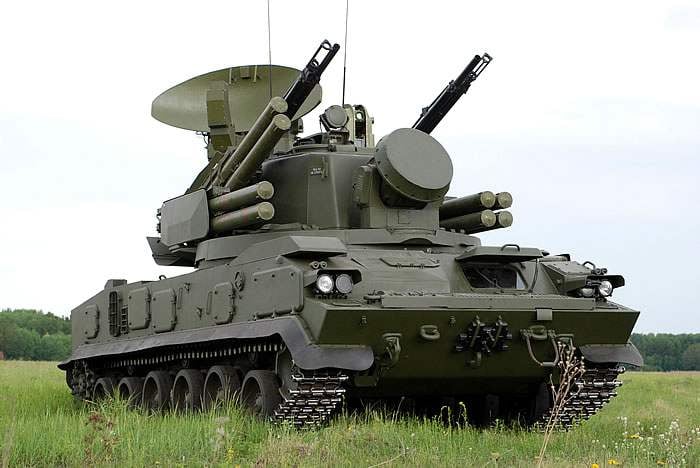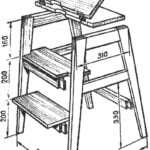 By the end of 1960-ies has increased its attention to the creation of highly mobile anti-aircraft army air defense short range, able to work as part of the advanced forces that could be attacked using anti-tank helicopters and low-flying enemy aircraft, as well as able, if necessary, to repel the attacks of enemy ground fire from anti-aircraft guns.
By the end of 1960-ies has increased its attention to the creation of highly mobile anti-aircraft army air defense short range, able to work as part of the advanced forces that could be attacked using anti-tank helicopters and low-flying enemy aircraft, as well as able, if necessary, to repel the attacks of enemy ground fire from anti-aircraft guns.
By the time the combat aircraft has confidently mastered the small and extremely small heights where they could fly at subsonic and supersonic speeds and use the means of electronic countermeasures. In turn, the first attack helicopters, armed with anti-tank missiles, have also demonstrated its high efficiency in the fight against armored vehicles. Tactics used by them, as a rule, was the lesson hidden in the folds of the terrain position and “jumping” up to a height of 15 — 25 meters with the consumption of ammunition anti-tank for 15 — 20 seconds. This tactic has led to a sharp decrease of the detection range of such air targets and to reduce time for data preparation to open fire.
Conducted in those years, the analysis showed that none of the available ground forces air defense systems unable to withstand such threats. At the same time was formulated and the main tactical and technical requirements of a new generation of anti-aircraft short range. They put the experience of the first years of operation self-propelled anti-aircraft “SHIPKA”, which showed that anti-aircraft artillery, along with anti-aircraft missiles, takes a worthy place in the Arsenal of means of struggle against modern enemy aircraft and able to effectively destroy manpower and armored vehicles of the enemy. But its shortcomings, such as a small zone of effective fire purposes, and insufficient power (power) of rounds required to defeat the new types of goals, can be overcome by increasing caliber automatic cannons up to 30 mm. In this case the expected reduction in 2 — 3 times required to defeat a target number of hits, increasing the efficiency of destruction of ground targets and maintaining the same rate of fire.
This complex was supposed to be in constant readiness to assessing the air situation and to detect air targets in motion, have low reaction time, high probability of target destruction, and also have high mobility and aviatransportations, low cost and relatively simple maintenance.
In full compliance with these requirements at the initial phase of the new complex was considered appropriate to develop a self-propelled anti-aircraft artillery, equipped with 30-mm cannons. However, the lack by the time a sufficient number of experimental data for testing the developed instrument Design Bureau of the defense Ministry the most appropriate 30-mm automatic guns AO-17 AO-18 is not allowed to recommend them for use in its composition. Experimental verification was subject to a number of complex issues related to the development of other elements of the installation — Radiopribor complexes, sights, shells, etc.
As a result, on 8 June 1970 on the initiative of the Main missile and artillery Directorate (GRAU) was adopted by the decision of Council of Ministers of the USSR that KBP in cooperation with other organizations of defensive industries held a scientific and experimental work to determine the feasibility of creating a new 30-mm type ZSU “Shilka”, which received the designation “Tunguska”. Soon developed the appropriate conceptual design, and in 1973 adopted a government resolution on the development of technical design and prototype ZSU “Tunguska”.
But the evaluation made by the time the CBI showed that the greatest efficiency of an army air defense system short-range can be achieved only with a combination of gun and missile armament. While missiles had to fire at air targets throughout the depth of the affected area, and cannon fire — planes flying at extremely low altitudes, and helicopters suddenly appearing from behind cover in the near zone. In addition, the cannons because of the low cost of munitions used was appropriate to apply to the defeat of the cheap and massive targets such as remotely piloted aircrafts and ground targets.
In 1973, by decision of the Council of Ministers was held the project “Dam”, the purpose of which was to find ways of protecting the Land forces, first and foremost of the advancing armored vehicles, attack helicopters. In carrying out this work on Donguzskom the landfill conducted a pilot exercise with combat firings on helicopters-targets from different types of weapons for the army. In 1975 with the aim of expanding the zone of fire objectives and enhance the combat effectiveness ZSU at the initiative of the CBI and 3rd research Institute of the Ministry of defense was considered appropriate to put on ZSU “Tunguska” additional missile weapons with an optical sight and radiotelephone anti-aircraft guided missiles (AAGM). In the same year, finally fulfilled the requirements for “Tunguska”, equipped with artillery and missile weapons.

SAM 9М311:
1 — fairing; 2 — compartment proximity Fuze; 3 — instrument Bay; 4 — rod warhead; 5 — gargrot; 6 — terraplan; 7 — fold console wing; 8 — front yoke; 9 — solid fuel launch booster; 10 — fold the console of the stabilizer; 11 — nozzle booster; 12 — aerodynamic wheel; 13 — connector cover; 14 — the switch contacts start circuit boosters; 15 — rear yoke; 16 — frame stabilizer; 17 — transition skirt mechanism of separation stages; 18 — compartment radio; 19 — fairing antenna of radio guidance; 20 — tracer; 21 — cover side of the connector; 22 — the axis of folding of the console stabilizer. The drawing is modeled after the Suhr, exhibited by the developer of the complex at the MAKS-95.
These proposals, as well as the feasibility of developing such ZSU, has caused great doubt in the leadership of the Ministry of defence. The basis for them, which led to the cessation of funding for the further development of the “Tunguska” in 1975 and 1977, was the fact that SAM “OSA-AK”, adopted in 1975, the weapons were close to her size area, and the effectiveness of destruction of low-flying aircraft. To continue work it took several years of persistent efforts undertaken by the head of the GROU p. N.Kuleshov, head of the 3rd research Institute A. N. By vaginam and CBI chief designer A. G. Shipunov. The main argument was the least reaction time new air defense system. In addition, analysis of the experience of the wars in Vietnam and the middle East confirmed the high efficiency of the helicopters.
The development of “Tunguska” was continued, and the chief designers of missiles, guns and steel by V. P. Gryazev and V. M. Kuznetsov.
The fundamental feature of “Tunguska”, compared to the known systems of anti-aircraft weapons, has become a combination in a single fighting machine gun and missile armament, radar and optical means of detection, tracking and fire control by radar with a detection range of air targets up to 16 — 18 km, radar tracking and ground interrogator, digital computing devices, sighting and optical equipment, and building Firepower “Tunguska” were two 30-mm automatic 2А38 with cooling system and ammunition, eight launchers with missiles 9М311 in transport-launch containers.
Creative search specialists, CBI has helped to create a single-stage anti-aircraft guided missile 9М311, unprecedented, bikalibernoy scheme, with detachable engine and the sustainer stage without the engine. Such scheme allowed to reach the missile is extremely high for the time characteristics. So, no engine sustainer stage missiles ruled out the smoke line of sight targets, ensuring reliable and accurate guidance of rockets, reduced its weight and size, simplified the layout of onboard equipment and military equipment.
Application bikalibernoy diagrams of rockets allowed almost twice compared to single-stage missiles, reduce its mass and to higher performance characteristics.
Both stages of the rocket launch and propulsion, made by the scheme “duck”, was equipped with a feathering, drop using the torsion spring after release of the missile from the container.
For the missiles created single-mode propulsion system (the average time of 2.6 s), the construction of which was made on the basis of plastic. The engine is clocked the rocket to a speed of 900 m/s and separated. The sustainer stage of the rocket, which had a mass of 18.5 kg, continued its flight in a ballistic mode. Her average speed was 600 m/s, and the average standing load — 18 units Is allowed to hit high-speed (500 m/s) and maneuvering (with overloads of up to 5 — 7.) goal on a collision course and the Dogon at ranges up to 8 km.
In the composition of the sustainer stage of the rocket were: antenna / waveguide system, the electronic control unit, gyroscopic coordinator, block steering gear, tracer, power pack and combat gear.
Combat gear of the rocket consisted of a 9-kg warhead, the contact fuse and a proximity sensor. Proximity sensor weight 0.8 kg consisted of 4 semiconductor lasers forming the 8-beam radiation pattern. The warhead was made in the form of compartment of large aspect ratio with rod striking elements to improve the efficiency of which it is also equipped with fragmentation elements. The undermining of warhead was carried out within a radius of 5 m from the target at the signal, proximity sensor, platoon radio command for 1 km before meeting the goal, and in direct contact — contact fuse. The probability of a direct hit at the target was about 60%.
The main characteristics zrpk “Tunguska”

Rocket delivered to the troops in the transport-launch container at the curb and does not require maintenance for 10 years.
When firing a missile was used target tracking in angular coordinates with an optical sight. To eliminate the influence of the smoke from the running engine to process the optical sight of the rocket at the launch site was used software arc-shaped trajectory output missiles. After launch, got into the field of view of the optical finder instrument for the allocation of coordinates. On the light signal tracer it worked out the angular coordinates of the missile relative to the line of sight targets received by the digital computing system, generates commands to control the rocket and pass her through the station tracking. The movement of missiles on almost all trajectories with deviation from the line of sight targets to reduce the probability that fire back end, the IR-traps in the field of view of the direction finder equipment selection coordinates missiles. Enter the rocket to the line of sight targets was started 2 — 3 to meet the purpose and end in close proximity to it.
After the time corresponding to 1000 m after the flight of the missile target, the complex is automatically translated in readiness for launch next-zour. In the absence of the digital computing system of the data about the target range uses an additional mode of guidance of missiles, where the missile is directly conducted to the line of sight targets, proximity sensor cocked in 3, 2 s after the rocket launch. Bringing the complex in readiness for the launch of the next rocket is performed after the time of flight of missiles at maximum range. When firing missiles at ground targets proximity sensor was turned off before launch. In this case the height limit control system was not required, only direct visibility of the target.
After the decision on the establishment of “Tunguska” missile-cannon version of the work went at a fast pace and in September 1980, at Donguzskom the landfill has begun the state tests of the complex. The Commission on tests of “Tunguska” was headed by Y. P. Belyakov, provided their conduct within a short time. In December 1981, was held the final of the shooting, and on September 8, 1982 2К22 complex “Tunguska” was adopted.
In the future, the complex repeatedly modernized. After the collapse of the Soviet Union began work on the replacement of produced in Belarus fighting vehicle chassis GM-352 was developed AT at Mytishchi Metrovagonmash GM-5975.
In an improved rocket 9М311-1M used radar instead of laser fuse, a tracer for tracking the missile was replaced by a pulsed light-the spotlight has increased on-Board systems. These innovations have significantly improved the security instrument from the optical interference and more likely to hit targets. The range of the affected area of the modified missile was increased to 10 km. the Level of combat efficiency of the complex “Tunguska-M1” in the presence of noise turned out to be 1.3 — 1.5 times higher compared to the “Tunguska-M”.
The work of the creators zrpk “Tunguska” praised the Soviet government: the winners of the Lenin award V. M. Kuznetsov,
D. A. Rus’yanov, A. G. Golovin, P. S. Kononov; State prize of I. P. Zykov, V. A. Korobkin, N. P.Bryzgalov,
B. G. Grandchildren and others. Many of the participants were awarded with orders and medals, and A,shipunova — the order of Lenin.
High combat and operational qualities “Tunguska” was repeatedly confirmed during exercises and combat training firings, the complex has been repeatedly demonstrated at the international exhibition of arms and military equipment.
About 20 “Tunguska” participated in military action to disarm illegal armed formations in Chechnya, was used for fire support troop armored group. Shots were fired at ground targets (in the fourth) and had developed tactics: the installation leaves for a short time from behind cover and firing to kill pre-proven targets and then returns to its place. This tactics brought good results. But not always in a combat situation were able to solve tasks without losses. During the new year’s storm of Grozny 31 December 1994 killed the commander of battery “Tunguska” Andrei Tarasenko, a graduate of the Poltava anti-aircraft higher the red banner command school N.F.Vatutina.
V. KOROVIN



